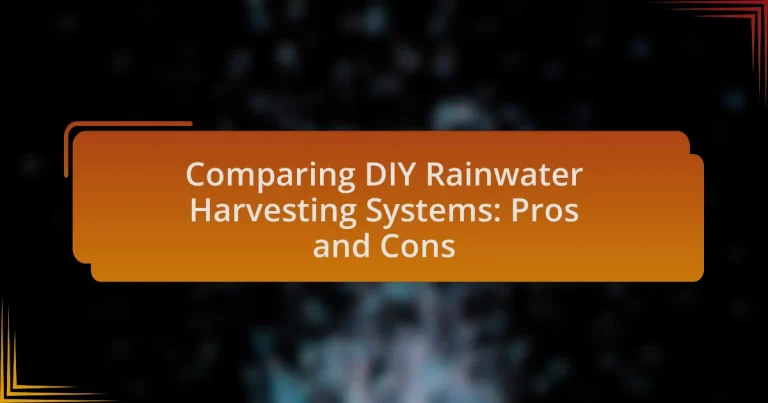DIY rainwater harvesting systems are self-constructed setups that collect and store rainwater for various uses, including irrigation and toilet flushing. This article examines the functionality, essential components, and advantages of these systems, highlighting their potential for cost savings and environmental benefits. It also addresses the challenges associated with DIY installations, such as maintenance requirements and local regulations, while comparing them to professional systems. Key considerations for successful implementation and common mistakes to avoid are discussed, providing a comprehensive overview of the pros and cons of DIY rainwater harvesting systems.
What are DIY Rainwater Harvesting Systems?

DIY rainwater harvesting systems are self-constructed setups designed to collect and store rainwater for various uses, such as irrigation, flushing toilets, or even potable water after proper treatment. These systems typically consist of components like gutters, downspouts, storage tanks, and filtration systems, allowing homeowners to utilize natural precipitation efficiently. According to the Environmental Protection Agency, rainwater harvesting can reduce water bills and alleviate pressure on municipal water supplies, making it a sustainable practice.
How do DIY Rainwater Harvesting Systems function?
DIY rainwater harvesting systems function by collecting and storing rainwater from surfaces such as roofs for later use. These systems typically include components like gutters, downspouts, storage tanks, and filtration systems to ensure the collected water is clean and usable. The process begins with rainwater falling on a catchment area, which directs the water into gutters that channel it to downspouts. The water then flows into a storage tank, where it can be filtered and treated for various applications, such as irrigation or non-potable household uses. According to the U.S. Environmental Protection Agency, rainwater harvesting can reduce water bills and decrease stormwater runoff, making it an effective method for sustainable water management.
What are the essential components of a DIY Rainwater Harvesting System?
The essential components of a DIY rainwater harvesting system include a catchment area, a conveyance system, a storage tank, and a filtration system. The catchment area, typically a roof, collects rainwater, which is then directed through the conveyance system, usually consisting of gutters and downspouts. The collected water is stored in a storage tank, which can vary in size depending on the intended use. Finally, a filtration system is necessary to ensure the water is clean and safe for use, removing debris and contaminants. These components work together to efficiently collect and store rainwater for various applications, such as irrigation or household use.
How is rainwater collected and stored in these systems?
Rainwater is collected in DIY rainwater harvesting systems primarily through roof catchment areas, where it flows into gutters and downspouts. These systems typically direct the collected water into storage tanks or cisterns, which can be above or below ground. The effectiveness of this collection method is supported by the fact that a well-designed system can capture a significant portion of rainfall, with estimates suggesting that a 1,000 square foot roof can yield approximately 600 gallons of water for every inch of rain.
What are the advantages of DIY Rainwater Harvesting Systems?
DIY rainwater harvesting systems offer several advantages, including cost savings, environmental benefits, and increased water independence. By constructing these systems themselves, individuals can significantly reduce installation costs compared to professional systems, which can range from hundreds to thousands of dollars. Additionally, DIY systems promote sustainability by utilizing a natural resource, helping to conserve municipal water supplies and reduce runoff that can lead to erosion and pollution. Furthermore, these systems empower homeowners to manage their own water supply, providing a reliable source during droughts or water shortages. According to the U.S. Environmental Protection Agency, rainwater harvesting can reduce water bills by up to 50%, demonstrating the financial benefits of such systems.
How do these systems contribute to water conservation?
DIY rainwater harvesting systems contribute to water conservation by capturing and storing rainwater for reuse, thereby reducing reliance on municipal water supplies. These systems can significantly decrease water consumption for irrigation, toilet flushing, and other non-potable uses, leading to lower water bills and less strain on local water resources. For instance, a typical household can collect thousands of gallons of rainwater annually, which can offset a substantial portion of its water usage, especially in regions with seasonal rainfall.
What cost savings can be achieved through DIY systems?
DIY systems can achieve significant cost savings by eliminating labor costs and reducing material expenses. For instance, individuals can save up to 50% on installation costs by constructing their own rainwater harvesting systems, as reported by the American Rainwater Catchment Systems Association. Additionally, using repurposed materials can further decrease expenses, with some DIY enthusiasts reporting total project costs as low as $200 compared to professional installations that can exceed $1,500. This approach not only minimizes financial outlay but also allows for customization based on specific needs and local conditions.
What are the potential drawbacks of DIY Rainwater Harvesting Systems?
DIY rainwater harvesting systems can present several potential drawbacks, including legal restrictions, maintenance challenges, and water quality concerns. Legal restrictions may arise from local regulations that limit or prohibit rainwater collection, impacting the feasibility of such systems. Maintenance challenges include the need for regular cleaning and inspection of components like gutters and storage tanks to prevent clogs and contamination. Additionally, water quality concerns stem from the possibility of pollutants entering the system, which can lead to health risks if the harvested water is used for drinking or irrigation without proper treatment.
What maintenance challenges do these systems present?
DIY rainwater harvesting systems present several maintenance challenges, including the need for regular cleaning of gutters and filters to prevent clogging. Over time, debris accumulation can lead to reduced water quality and system efficiency. Additionally, these systems require periodic inspection of storage tanks for leaks and contamination, as stagnant water can foster algae growth and mosquito breeding. The variability in rainfall can also complicate maintenance schedules, necessitating adjustments to ensure optimal water collection and storage.
How do local regulations impact the feasibility of DIY systems?
Local regulations significantly impact the feasibility of DIY systems by dictating what is permissible in terms of construction, installation, and usage. For instance, many municipalities have specific codes regarding rainwater harvesting, including requirements for permits, system design, and maintenance practices. These regulations can either facilitate or hinder the implementation of DIY systems; for example, a lack of clear guidelines may discourage individuals from pursuing such projects due to uncertainty about compliance. Conversely, supportive regulations can promote DIY initiatives by providing clear frameworks and incentives, such as tax credits or rebates for sustainable practices.
How do DIY Rainwater Harvesting Systems compare to professional installations?
DIY rainwater harvesting systems are generally more cost-effective than professional installations, but they often lack the efficiency and reliability of professionally designed systems. DIY systems can be assembled using readily available materials, which significantly reduces initial costs; however, they may not meet local regulations or optimal design standards, leading to potential issues such as inadequate water quality or insufficient storage capacity. In contrast, professional installations typically involve expert assessment, tailored design, and compliance with regulations, ensuring higher efficiency and better long-term performance. Studies indicate that professionally installed systems can capture and utilize up to 50% more rainwater compared to DIY setups, highlighting the advantages of professional expertise in maximizing water collection and usage.
What factors should be considered when choosing a DIY system?
When choosing a DIY rainwater harvesting system, factors such as local regulations, system capacity, materials, installation complexity, and maintenance requirements should be considered. Local regulations dictate what is permissible for rainwater collection, influencing design and implementation. System capacity must align with rainfall patterns and water needs, ensuring efficiency. The choice of materials affects durability and cost; for instance, food-grade materials are essential for potable water systems. Installation complexity varies, with some systems requiring advanced skills, while others are more user-friendly. Lastly, maintenance requirements impact long-term usability; systems that are easier to maintain can lead to better performance and longevity.
What are the best practices for implementing a DIY Rainwater Harvesting System?
The best practices for implementing a DIY rainwater harvesting system include selecting an appropriate collection surface, using high-quality storage tanks, ensuring proper filtration, and adhering to local regulations. Choosing a roof made of non-toxic materials, such as metal or tile, maximizes water quality and collection efficiency. High-quality storage tanks, preferably made of food-grade plastic or fiberglass, prevent contamination and ensure durability. Installing a first-flush diverter effectively removes debris and contaminants from the initial rainfall, enhancing water quality. Additionally, compliance with local regulations is crucial, as many areas have specific guidelines regarding rainwater harvesting systems to ensure safety and legality.
How can one ensure the quality of harvested rainwater?
To ensure the quality of harvested rainwater, one should implement proper filtration and regular maintenance of the collection system. Filtration systems, such as first-flush diverters, remove debris and contaminants from the initial rainfall, which is often the dirtiest. Regular maintenance, including cleaning gutters and storage tanks, prevents the buildup of algae and sediment, which can compromise water quality. Additionally, testing the water for contaminants like bacteria and heavy metals can provide assurance that the harvested rainwater is safe for its intended use. Studies indicate that untreated rainwater can harbor pathogens, making regular testing essential for safe consumption.
What common mistakes should be avoided in DIY installations?
Common mistakes to avoid in DIY installations include inadequate planning, improper measurements, and neglecting local regulations. Inadequate planning can lead to unforeseen complications during installation, while improper measurements may result in components that do not fit correctly, causing inefficiencies or failures. Additionally, neglecting local regulations can result in legal issues or fines, as many areas have specific codes governing rainwater harvesting systems. Ensuring thorough preparation, accurate measurements, and compliance with regulations can significantly enhance the success of DIY installations.


